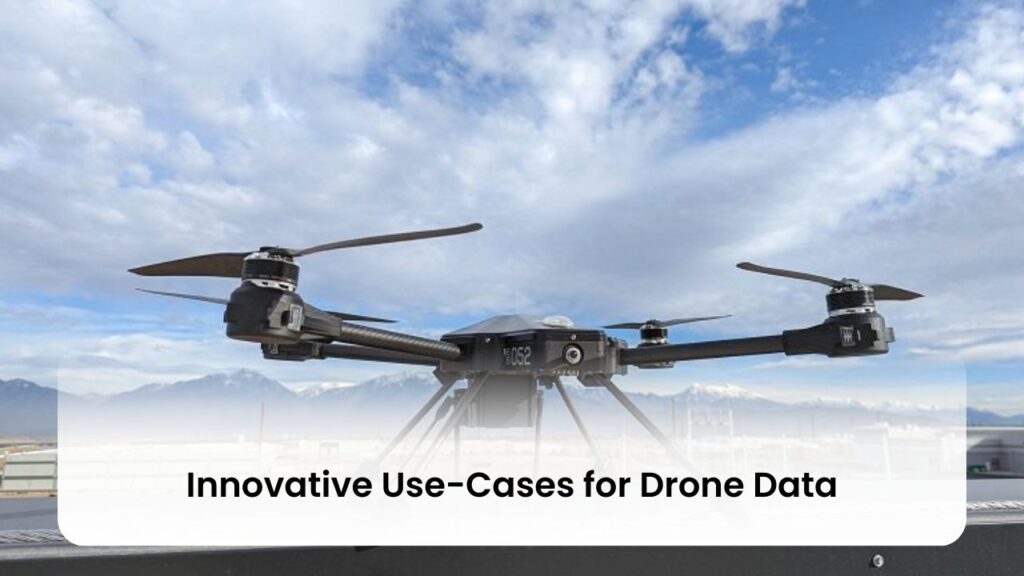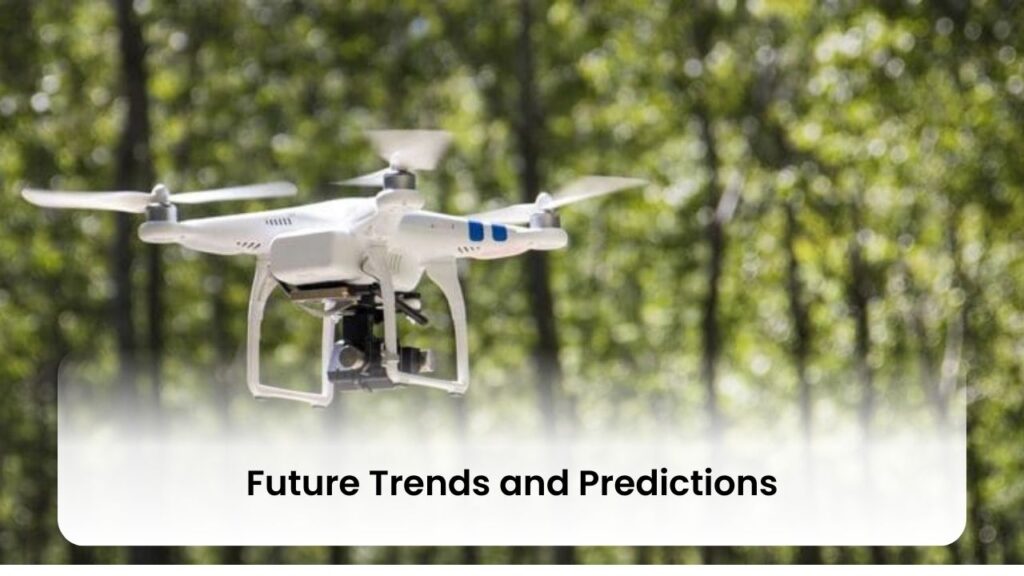With the Drone Data Services market size reaching a significant value in 2023 and anticipated growth to millions by 2031, the drone economy is witnessing an unprecedented boom. This surge is underscored by a dramatic increase in commercial drone operations, which, through the capturing and processing of vast amounts of raw data, unlock new horizons in data monetization in the drone economy. Given this landscape, turning aerial insights into revenue streams has become a key focus area, with the potential to revolutionize industries by optimizing business processes and driving economic growth.
The process of data monetization, crucial for generating economic benefits from drone-captured data, involves a paradigm shift in how data is perceived—from a mere operational cost to a valuable asset. This transition not only necessitates a deep dive into legal and regulatory considerations but also calls for a strategic approach to navigate the four stages of data monetization. As companies increasingly leverage drone technology for applications ranging from photography to delivery, the importance of harnessing aerial data to fuel economic growth is more pertinent than ever. This article will explore the dynamics of data monetization within the drone economy, highlighting the challenges, strategies, and future trends that are shaping this exciting field.
The Growth of the Drone Market

The drone market’s growth trajectory is underscored by a dynamic shift from hardware to service-based valuation, reflecting an evolving industry landscape. Key points include:
Revenue Generation
Initially hit by the pandemic, the drone services industry has pivoted, with nearly half of Drone Service Providers (DSPs) now generating revenues exceeding $50K USD in 2021. This marks a significant rebound and points towards a robust recovery and potential for profitability.
Market Valuation and Projections
2021: The Drone Data Services Market was valued at USD 870.0 million.
2027 Forecast: Expected to surge to USD 12734.64 million, exhibiting a CAGR of 56.4%.
2025 Outlook: The broader drone market is projected to grow to over $42 billion, emphasizing the rapid expansion and investment interest in this sector.
Segment Growth and Leadership
Consumer Drones: Hold approximately 70% of the market share, indicating a strong consumer demand.
Commercial and Enterprise Segments: Forecasted to exhibit the fastest growth rates, with enterprise becoming the largest segment post-2024, surpassing defense as the dominant market force.
This data illustrates not only the resilience of the drone market but also its potential for sustained growth and innovation, driven by both consumer interest and enterprise applications.
Challenges in Drone Data Monetization
Nitin Mittal, Senior Vice President for Analytics at The Builder’s Group, brings to light the transient nature of data’s value, likening it to soil with the potential to bear various fruits. He identifies three primary avenues for monetizing data:
Internally
Enhancing operational efficiency and decision-making within the organization.
Customer-facing
Improving products or services based on insights derived from data.
Externally
Selling or licensing data to third parties.
However, challenges abound in realizing the full potential of drone data monetization. Key among these are:
Data Governance and Privacy
Establishing robust data management practices to ensure privacy and transparency.
Market Saturation
The proliferation of aerial photography and videography services has led to intense competition, necessitating a unique value proposition for differentiation.
Regulatory Hurdles
Navigating a complex landscape of regulations, including issues with illegal operators and Beyond Visual Line of Sight (BVLOS) restrictions, poses significant challenges.
Technical Challenges
The logistics of storing, transferring, and analyzing large volumes of drone data, especially for smaller startups, require sophisticated solutions, such as cloud storage and custom-developed software for automation.
These challenges underscore the importance of building a data-driven culture within organizations and adopting innovative strategies to leverage drone technology effectively, turning aerial insights into lucrative revenue streams.
Case Studies: Successful Monetization Strategies
In the realm of real estate, drone photography has revolutionized property marketing, with listings featuring aerial images selling 68% faster. This innovative approach not only offers potential buyers a comprehensive view of the property but also significantly enhances the property’s appeal. Here are some key strategies that have proven successful:
Virtual Property Tours
Utilizing drones to create immersive virtual tours, allowing potential buyers to explore properties remotely.
Efficient Property Inspections
Capturing high-quality images and videos from various angles for detailed property inspections.
Agriculture and construction industries have also seen substantial benefits from drone technology:
Precision Agriculture
Drones equipped with advanced sensors provide detailed images of crops, facilitating optimized crop management by monitoring health, soil moisture, and more.
Construction Monitoring
High-resolution cameras on drones are instrumental in creating accurate 3D models and maps, aiding in efficient project monitoring and planning.
Moreover, enhancing online presence through a well-designed website, developing niche content, and leveraging social media advertising are critical for attracting potential clients. Establishing authority in the field and building professional relationships can lead to increased referrals and partnerships, further driving business growth.
Innovative Use-Cases for Drone Data

In the rapidly evolving drone economy, innovative use-cases for drone data are emerging across various industries, each harnessing the power of aerial insights to enhance efficiency, safety, and engagement. Below are some of the most compelling applications:
Delivery Services
Company A: An e-commerce giant streamlines delivery, cutting times significantly.
Company B: A startup optimizes last-mile deliveries using drones with advanced navigation algorithms, slashing costs.
Brand Engagement
Company C: A sportswear brand boosts awareness and customer interaction through a drone-powered city-wide scavenger hunt.
Drone Photogrammetry Applications
- Property Development: Creating 3D models for stakeholders.
- Volume Metrics: Accurate measurement of materials like dirt or gravel.
- Tax Assessment: Efficient mapping of large areas for reliable tax assessment.
- Digital Assets Creation: Generating hyper-realistic environments for video games, sold as NFTs.
AI-Enabled Drone Applications
- Agriculture: Monitoring crops for health, pests, or nutrient deficiencies.
- Construction: Collecting data for project progress and safety compliance.
- Delivery: Reaching remote areas swiftly, reducing delivery time and cost.
- Security: Performing reconnaissance and surveillance missions.
These applications underscore the versatility of drone data in transforming operations and experiences across sectors, highlighting the drone economy’s potential for innovation and growth.
The Role of AI and Machine Learning
In the evolving drone economy, Artificial Intelligence and Machine Learning are pivotal in enhancing drone capabilities, offering predictive insights, and automating operations. These technologies empower drones with autonomy, enabling them to perform complex tasks previously requiring human intelligence, such as navigation, obstacle avoidance, and data analysis. Here’s a breakdown of how AI and ML are revolutionizing drone operations:
Autonomous Flight and Operations
- GPS Coordinates: Drones navigate autonomously using precise GPS locations.
- Object Recognition: Identifying objects to avoid or track during flight.
- Voice Control: Commanding drones through voice instructions for hands-free operation.
Enhanced Data Processing and Analysis
- Computer Vision (CV): Extracts meaningful information from aerial images for analysis.
- Machine Learning (ML): Employs neural networks to process vast datasets, aiding in decision-making.
- Deep Learning (DL): A specialized ML approach for intricate data analysis, crucial for tasks like inspection and maintenance.
Operational Efficiency and Safety
- Navigation and Obstacle Avoidance: AI analyzes surroundings to plot efficient flight paths.
- Object Tracking: Precise tracking of objects for applications in surveillance and search and rescue.
- Automated Data Collection: Streamlines the gathering and analysis of data, enhancing productivity in agriculture and infrastructure inspection.
AI and ML not only expand the operational capabilities of drones but also ensure safer, more efficient missions, opening up new avenues for data monetization in the drone economy.
Future Trends and Predictions

As we peer into the future of drone technology and its role in data monetization, several key trends and predictions emerge, shaping the trajectory of the drone economy. These insights not only highlight the evolving capabilities of drones but also underscore the innovative strategies businesses can employ to harness aerial data for economic gain.
Integration and Technological Advancements
- Improved battery life for extended operations
- Integration with smartphones for enhanced control and data sharing
- Development of 6G technology for superior drone communication
- Adoption of solar-powered drones to overcome battery limitations
Regulatory Evolution and Market Dynamics
- Increased regulations for safer drone operations
- Growth in drone use in urban areas for delivery and surveillance
- Integration with the Internet of Things (IoT) for smarter data exchange
Innovative Use-Cases and Business Models
- Utilization of swarm technology for complex tasks
- Telecom infrastructure inspection and maintenance leveraging precise aerial imaging
- Establishment of drone traffic control centers by telecom operators
- Offering drone-based data management services to enhance data transfer, storage, and analytics
These trends signify a dynamic shift towards more integrated, efficient, and innovative use of drone technology, presenting new avenues for data monetization in the drone economy.
Explore More Categories:
Conclusion
The drone economy is at the cusp of transforming industries by converting aerial data into significant revenue streams, as highlighted throughout this article. Summarizing the main points, the surge in commercial drone operations has facilitated the movement towards data monetization, reflecting on the massive potential to optimize business processes and economic growth. Integrating AI and machine learning has further pushed the boundaries by enhancing drone capabilities, emphasizing the transition of data from an operational cost to a valuable asset. This evolution underscores the importance of a strategic approach in navigating the complexities of data monetization within the burgeoning drone economy.
FAQs
Q. What is drone data monetization?
Drone data monetization refers to the process of generating economic benefits by capturing, processing, and utilizing data gathered through drone operations. It involves transforming raw aerial data into actionable insights, products, or services that can generate revenue.
Q. What are some key challenges in drone data monetization?
Key challenges include navigating data privacy and governance issues, overcoming market saturation, dealing with regulatory hurdles, and addressing the technical challenges of managing large volumes of data.
Q. Can you provide examples of successful drone data monetization strategies?
Successful strategies include using drones for immersive virtual property tours in real estate, optimizing crop management through precision agriculture, and employing drones for efficient project monitoring in construction.
Q. How are AI and machine learning revolutionizing drone operations?
AI and machine learning are enhancing drone capabilities by enabling autonomous flight, object recognition, and enhanced data processing. These technologies allow drones to perform complex tasks with greater efficiency and accuracy.
Q. What future trends are expected in the drone economy?
Future trends include technological advancements for extended drone operations, increased regulatory clarity, innovative use cases such as swarm technology and telecom infrastructure inspection, and the integration of drones with IoT for smarter data exchange.
